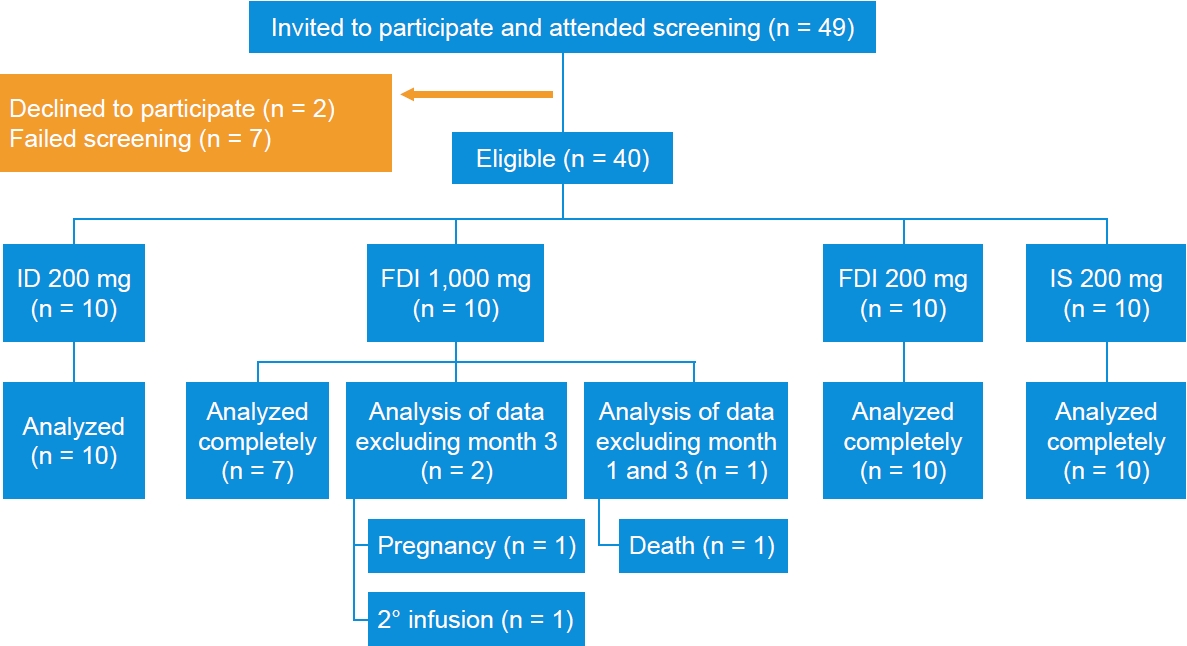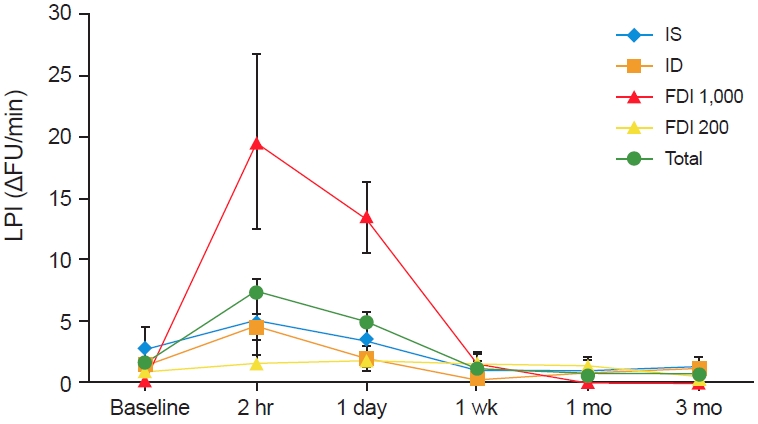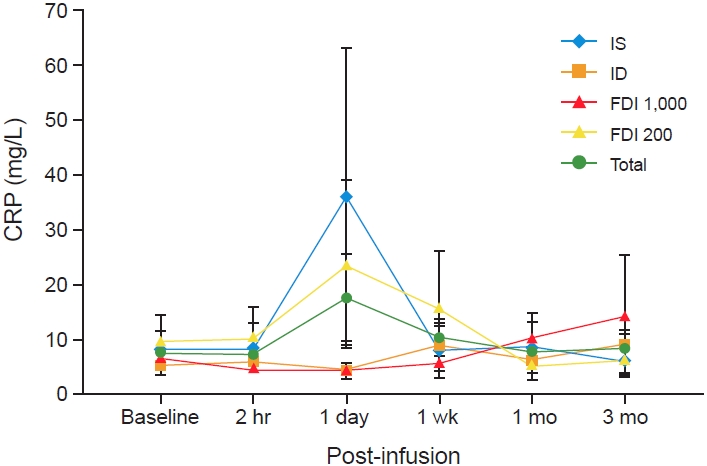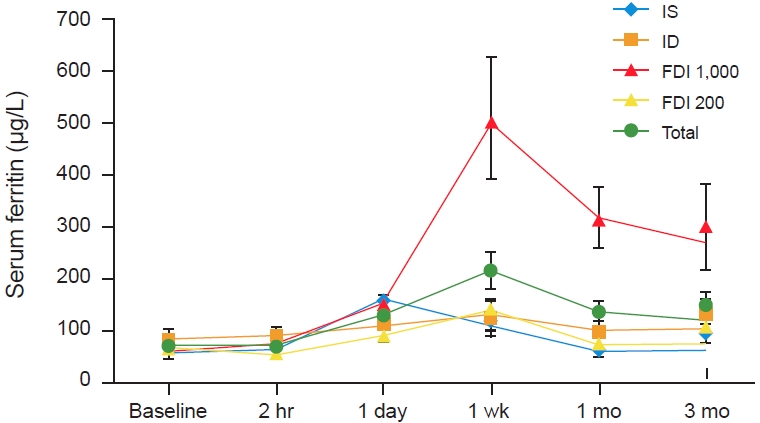1. GBD 2016 Disease and Injury Incidence and Prevalence Collaborators. Global, regional, and national incidence, prevalence, and years lived with disability for 328 diseases and injuries for 195 countries, 1990-2016: a systematic analysis for the Global Burden of Disease Study 2016.
Lancet 2017;390:1211–1259.


2. Camaschella C. Iron-deficiency anemia.
N Engl J Med 2015;372:1832–1843.


3. Keshav S, Stevens R. New concepts in iron deficiency anaemia.
Br J Gen Pract 2017;67:10–11.



4. Bhandari S, Pereira DIA, Chappell HF, Drakesmith H. Intravenous irons: from basic science to clinical practice.
Pharmaceuticals (Basel) 2018;11:82.



5. National Institute for Health and Care Excellence. NICE guideline NG8. Chronic kidney disease: managing anaemia [Internet]. London (UK): National Institute for Health and Care Excellence, c2015 [cited 2020 Jul 7]. Available from:
https://www.nice.org.uk/guidance/ng8.
6. Kidney Disease: Improving Global Outcomes (KDIGO) Anemia Work Group. KDIGO clinical practice guideline for anemia in chronic kidney disease. Kidney Int Suppl 2012;2:279–335.
7. Agarwal R, Kusek JW, Pappas MK. A randomized trial of intravenous and oral iron in chronic kidney disease.
Kidney Int 2015;88:905–914.



8. Zager RA, Johnson AC, Hanson SY. Parenteral iron nephrotoxicity: potential mechanisms and consequences.
Kidney Int 2004;66:144–156.


9. Mimić-Oka J, Savić-Radojević A, Pljesa-Ercegovac M, et al. Evaluation of oxidative stress after repeated intravenous iron supplementation.
Ren Fail 2005;27:345–351.


10. Shah SV, Baliga R, Rajapurkar M, Fonseca VA. Oxidants in chronic kidney disease.
J Am Soc Nephrol 2007;18:16–28.


11. Cabantchik ZI. Labile iron in cells and body fluids: physiology, pathology, and pharmacology.
Front Pharmacol 2014;5:45.



12. Bresgen N, Eckl PM. Oxidative stress and the homeodynamics of iron metabolism.
Biomolecules 2015;5:808–847.



13. Zager RA, Johnson AC, Hanson SY, Wasse H. Parenteral iron formulations: a comparative toxicologic analysis and mechanisms of cell injury.
Am J Kidney Dis 2002;40:90–103.


14. Johnson AC, Becker K, Zager RA. Parenteral iron formulations differentially affect MCP-1, HO-1, and NGAL gene expression and renal responses to injury.
Am J Physiol Renal Physiol 2010;299:F426–F435.



15. Jahn MR, Andreasen HB, Fütterer S, et al. A comparative study of the physicochemical properties of iron isomaltoside 1000 (Monofer), a new intravenous iron preparation and its clinical implications.
Eur J Pharm Biopharm 2011;78:480–491.


16. Zheng H, Huang X, Zhang Q, Katz SD. Iron sucrose augments homocysteine-induced endothelial dysfunction in normal subjects.
Kidney Int 2006;69:679–684.



17. Kuo KL, Hung SC, Lee TS, Tarng DC. Iron sucrose accelerates early atherogenesis by increasing superoxide production and upregulating adhesion molecules in CKD.
J Am Soc Nephrol 2014;25:2596–2606.



18. Agarwal R, Rizkala AR, Kaskas MO, Minasian R, Trout JR. Iron sucrose causes greater proteinuria than ferric gluconate in non-dialysis chronic kidney disease.
Kidney Int 2007;72:638–642.


19. Ziedan A, Bhandari S. Protocol and baseline data for a prospective open-label explorative randomized single-center comparative study to determine the effects of various intravenous iron preparations on markers of oxidative stress and kidney injury in chronic kidney disease (IRON-CKD).
Trials 2019;20:194.



20. Finkelstein FO, van Nooten F, Wiklund I, Trundell D, Cella D. Measurement properties of the Short Form-36 (SF-36) and the Functional Assessment of Cancer Therapy-Anemia (FACT-An) in patients with anemia associated with chronic kidney disease.
Health Qual Life Outcomes 2018;16:111.



21. Ziedan A, Kassianides X, Bhandari S. Correction to: protocol and baseline data for a prospective open-label explorative randomized singlecenter comparative study to determine the effects of various intravenous iron preparations on markers of oxidative stress and kidney injury in chronic kidney disease (IRON-CKD).
Trials 2020;21:273.



22. Connor JR, Zhang X, Nixon AM, Webb B, Perno JR. Comparative evaluation of nephrotoxicity and management by macrophages of intravenous pharmaceutical iron formulations.
PLoS One 2015;10:e0125272.



23. Fütterer S, Andrusenko I, Kolb U, Hofmeister W, Langguth P. Structural characterization of iron oxide/hydroxide nanoparticles in nine different parenteral drugs for the treatment of iron deficiency anaemia by electron diffraction (ED) and X-ray powder diffraction (XRPD).
J Pharm Biomed Anal 2013;86:151–160.


24. Garbowski MW, Bansal SS, Porter JB, Burckhardt S, Hider R. NTBI is transiently generated from two compartments during a single dose of intravenous iron - a randomized controlled clinical study.
Blood 2019;134(Suppl 1):2234.

25. Bhandari S, Kalra PA, Berkowitz M, Belo D, Thomsen LL, Wolf M. Safety and efficacy of iron isomaltoside 1000/ferric derisomaltose versus iron sucrose in patients with chronic kidney disease: the FERWON-NEPHRO randomized, openlabel, comparative trial.
Nephrol Dial Transplant 2020 Feb 12 [Epub]. Doi: 10.1093/ndt/gfaa011.

26. Ma X, Yan W, Zheng H, et al. Regulation of IL-10 and IL-12 production and function in macrophages and dendritic cells.
F1000Res 2015;4:F1000 Faculty Rev-1465.



27. Macdougall IC, White C, Anker SD, et al. Intravenous iron in patients undergoing maintenance hemodialysis.
N Engl J Med 2019;380:447–458.


28. Miles LF, Litton E, Imberger G, Story D. Intravenous iron therapy for non-anaemic, iron-deficient adults.
Cochrane Database Syst Rev 2019;12:CD013084.


29. Schaller G, Scheiber-Mojdehkar B, Wolzt M, et al. Intravenous iron increases labile serum iron but does not impair forearm blood flow reactivity in dialysis patients.
Kidney Int 2005;68:2814–2822.


30. McEver RP. Selectins: initiators of leucocyte adhesion and signalling at the vascular wall.
Cardiovasc Res 2015;107:331–339.



31. Kartikasari AE, Georgiou NA, Visseren FL, van Kats-Renaud H, van Asbeck BS, Marx JJ. Intracellular labile iron modulates adhesion of human monocytes to human endothelial cells.
Arterioscler Thromb Vasc Biol 2004;24:2257–2262.


32. Kulnigg-Dabsch S, Schmid W, Howaldt S, et al. Iron deficiency generates secondary thrombocytosis and platelet activation in IBD: the randomized, controlled thromboVIT trial.
Inflamm Bowel Dis 2013;19:1609–1616.


33. Eliadou E, Kini G, Huang J, Champion A, Inns SJ. Intravenous iron replacement improves quality of life in hypoferritinemic inflammatory bowel disease patients with and without anemia.
Dig Dis 2017;35:444–448.


34. Macdougall IC, Bhandari S, White C, et al. Intravenous iron dosing and infection risk in patients on hemodialysis: a prespecified secondary analysis of the PIVOTAL trial.
J Am Soc Nephrol 2020;31:1118–1127.



35. Bhandari S, Kalra PA, Kothari J, et al. A randomized, openlabel trial of iron isomaltoside 1000 (Monofer®) compared with iron sucrose (Venofer®) as maintenance therapy in haemodialysis patients.
Nephrol Dial Transplant 2015;30:1577–1589.



36. Kalra PA, Bhandari S, Saxena S, et al. A randomized trial of iron isomaltoside 1000 versus oral iron in non-dialysisdependent chronic kidney disease patients with anaemia.
Nephrol Dial Transplant 2016;31:646–655.


37. Nuhu F, Seymour AM, Bhandari S. Impact of intravenous iron on oxidative stress and mitochondrial function in experimental chronic kidney disease.
Antioxidants (Basel) 2019;8:498.



38. Koskenkorva-Frank TS, Weiss G, Koppenol WH, Burckhardt S. The complex interplay of iron metabolism, reactive oxygen species, and reactive nitrogen species: insights into the potential of various iron therapies to induce oxidative and nitrosative stress.
Free Radic Biol Med 2013;65:1174–1194.


39. Meroño T, Dauteuille C, Tetzlaff W, et al. Oxidative stress, HDL functionality and effects of intravenous iron administration in women with iron deficiency anemia.
Clin Nutr 2017;36:552–558.


40. Wolf M, Rubin J, Achebe M, et al. Effects of iron isomaltoside vs ferric carboxymaltose on hypophosphatemia in iron-deficiency anemia: two randomized clinical trials.
JAMA 2020;323:432–443.

















 PDF Links
PDF Links PubReader
PubReader ePub Link
ePub Link Full text via DOI
Full text via DOI Download Citation
Download Citation Supplement 1
Supplement 1 Print
Print















